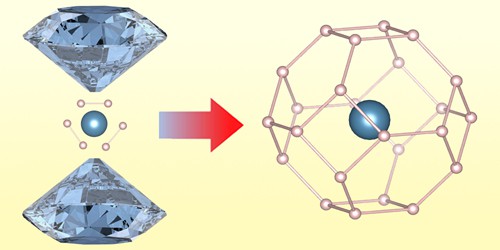Clathrate superhydride makes new high-temperature superconductor
06 Jun 2022 Isabelle Dumé

Researchers in China have synthesized a new type of high-temperature superconductor, clathrate calcium hydride (CaH6). The material, which is superconducting at temperatures of 215 K and pressures of 172 GPa (1.72 Mbar), is one of best high-temperature superhydrides made to date and the only clathrate hydride outside the family of rare-earth and actinide hydrides.
Superconductivity is the ability of a material to conduct electricity without any resistance. It is observed in many materials when they are cooled to below their superconducting transition temperature (Tc). In the Bardeen–Cooper–Schrieffer (BCS) theory of (“conventional”) superconductivity, this occurs when electrons overcome their mutual electrical repulsion and form so-called Cooper pairs that then travel unhindered through the material as a supercurrent.
Superconductivity was first observed in 1911 in solid mercury below a Tc of 4.2 K and the search for room-temperature superconductors has been on ever since. Finding a material that superconducts at such high temperatures would considerably improve the efficiency of electrical generators and transmission lines, while also making common applications of superconductivity, such as superconducting magnets in particle accelerators, simpler and cheaper.
Compressed hydrides
Physicists came a step closer to this “holy grail” of condensed-matter physics thanks to the copper oxide (cuprate) superconductors, which were discovered in the 1980s and 1990s and which include materials with Tc above 77 K, the temperature at which nitrogen becomes a liquid. Then, in 2015, the role of pressure came to the fore as researchers discovered that hydrogen sulphide has a Tc of 203 K when compressed to pressures of 150 GPa. This result spurred a flurry of interest in the compressed hydrides containing rare-earth or actinide elements.
Using quantum-mechanics-based calculations, two independent teams, led by Russell Hemley at George Washington University in the US and Yanming Ma at Jilin University in China, predicted in 2017 that lanthanum hydride (LaH10) could be superconducting. Hemley’s team went on to synthesize the material, and in May 2018 reported direct measurements of its conductivity indicating a Tc of 260 K at 180–200 GPa, posting a paper on the arXiv in August 2018 that was then published in Physical Review Letters. The team then reported additional measurements showing a Tc of up to 280 K in some samples in August 2018 at the Boston ACS meeting. A separate team led by Mikhail Eremets at the Max Planck Institute for Chemistry in Germany reported a Tc of 250 K for lanthanum hydride synthesized at pressures of around 170 GPa in work posted on the arXiv in December 2018 and subsequently published in Nature.
A class of currently unexplored superconductors
Now, Yanming Ma and colleagues at the State Key Laboratory of Superhard Materials, College of Physics, Jilin University, China have succeeded in synthesizing a new type of superhydride altogether, one that contains an alkaline-earth metal instead of a rare-earth metal or an actinide. The discovery “opens the door to a class of superconductors that is currently unexplored,” the researchers claim.
Although CaH6 was first predicted to be a superconductor a decade ago, it proved difficult to synthesize because calcium and hydrogen are highly reactive. When the two elements are brought together at low pressures, the result is often a hydride with an undesirably low hydrogen content.
In the new work, Ma and colleagues overcame this problem by using ammonia borane (BH3NH3) as a hydrogen source. This allowed them to synthesize CaH6 via a direct reaction between Ca and H2 at high temperatures and pressures.READ MORE

“We used a special sample loading method to synthesize the material at close to 200 GPa and temperatures of 2000 K in a diamond anvil cell with microelectrodes that we carefully mounted on the tips of the anvil for subsequent electrical conductivity measurements,” team member Hongbo Wang explains.
“The dramatic loss of resistance is very similar to the other superconductivity transitions that we have previously studied under pressure,” he tells Physics World, “and we have reproduced the result many times.”
According to the researchers, their new work will help to advance our understanding of superconductivity and could lead to new classes of ternary calcium-based superhydrides. The team is now busy exploring a broader range of compositions based on their own and other group’s calculations. “We believe this system is just one of many superhydrides, with likely higher Tc values,” says Wang.
The present research is detailed in Physical Review Letters.
from physicsworld.com 8/6/2022
Δεν υπάρχουν σχόλια:
Δημοσίευση σχολίου